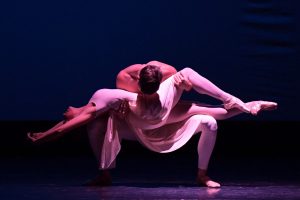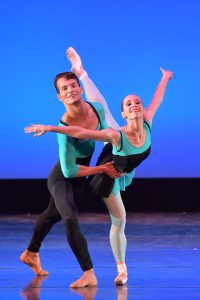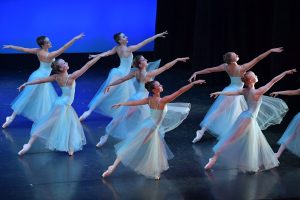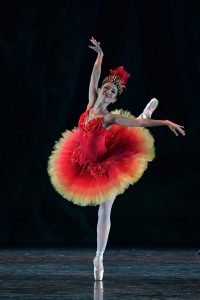New Dancers Dazzle in City Ballet of San Diego’s Season Opener

Elizabeth Fittro and Brian Heil in “Samuel Barber Adagio.” Photo: Anna Scipione
“The Firebird,” the kickoff program for City Ballet of San Diego’s 2017-18 season, put some stunning new company members onstage at the Spreckels Theatre last weekend. And veteran City Ballet dancers, most notably Ariana Gonzalez, looked at the top of their game in repertory that included the Balanchine classic “Serenade” and the company premiere of Peter Martins’ relentlessly paced “Ash.”
The one disappointment came at the end of the four-dance program, with the title piece, “The Firebird.” But until then, City Ballet dazzled.

Iago Breschi and Ariana Gonzalez in “Ash.” Photo: Anna Scipione
In “Ash,” a pell-mell score by Michael Torke chases five pairs of dancers across the stage. Dissonances in the music are echoed by choreography that skirts the edge of awkwardness, particularly when the women must cleanly strike a pose, then almost immediately strike another. At times, in the Saturday performance, dancers seemed to struggle to keep up; so did some of the musicians in the City Ballet Orchestra. But nothing was too fast for the lead couple, Gonzalez and a powerful newcomer, Iago Breschi. Gonzalez’s arms looked fluid even at full tilt, as if she had WD-40 in her shoulders, and Breschi danced with clean-lined authority.
Brian Heil stood out in a high-leaping solo in “Ash.” He was equally impressive partnering Elizabeth Fittro, a ravishing new company dancer, in “Samuel Barber Adagio.” Created by City Ballet resident choreographer Elizabeth Wistrich, the pas de deux features athletic, often improbable lifts—when the curtain opened, Heil was holding Fittro perpendicularly across his shoulders, and people gasped. The two stayed in tender physical contact for almost the entire dance. And the orchestra, directed by John Nettles, did a fine job with Barber’s elegiac Adagio for Strings.

“Serenade.” Photo: Anna Scipione
Set to Tchaikovsky’s Serenade in C major for String Orchestra, “Serenade” offers a delicious swirl of ballerinas in diaphanous ice-blue skirts, romantic partnering, and hints of narrative that have fueled debate—is there any story, or is it pure dance?—since George Balanchine created the ballet in 1934. It’s only through popular usage, rather than Balanchine’s direction, that the three lead women even have names: the Waltz Girl, the Russian Girl, and the Dark Angel.
On Saturday, Gonzalez was lovely as the Waltz Girl, though her pas de deux with Lucas Ataide, seemed short on romanticism. Megan Jacobs brought an elegant port de bras and nimble feet to the Russian Girl. But the wow moments came from Marta Kelly as the Dark Angel. A quicksilver sprite, Kelly (an apprentice in the company) delivered high, precise leaps and megawatts of rapture.
Everything about “The Firebird” looked right—the magical-garden set (acquired from New York), Sumire Ito’s sparkly red Firebird tutu and headdress, and Geoff Gonzalez as a tsar with appropriately regal bearing. And the orchestra met the challenges of the Stravinsky score.

Summer Ito as the Firebird. Photo: Anna Scipione
Elizabeth Wistrich created this “Firebird” in 1979, using an abridged 30-minute version of the 50-minute score. And, although the ballet hit all of the story’s high points—involving an evil sorcerer holding maidens captive—it felt like a Cliff’s Notes “Firebird,” without the magic. Ito, another new company member, brought clean-lined arabesques to her Firebird, but I wanted to see more birdlike arms and legs. Gonzalez didn’t get a lot to do besides looking princely. And the sorcerer’s minions reminded me of the mice in “The Nutcracker”—more cute than scary. Ryosuke Ogura, doing decisive leaps as the sorcerer, was the one dancer who brought real fire to the stage.
The lackluster “Firebird” aside, however, the opening program of City Ballet’s season shows the ambitious company continuing to push its dancers to master difficult choreography, and both veteran and new dancers look equal to the task.
The show ran last weekend only. Your next chance to see City Ballet will be when they perform “The Nutcracker” in December.

Award-winning dance journalist Janice Steinberg has published more than 400 articles in the San Diego Union-Tribune, Dance Magazine, the Los Angeles Times, and elsewhere. She was a 2004 New York Times-National Endowment for the Arts fellow at the Institute for Dance Criticism and has taught dance criticism at San Diego State University. She is also a novelist, author of The Tin Horse (Random House, 2013). For why she’s passionate about dance, see this article on her web site, The Tin Horse
